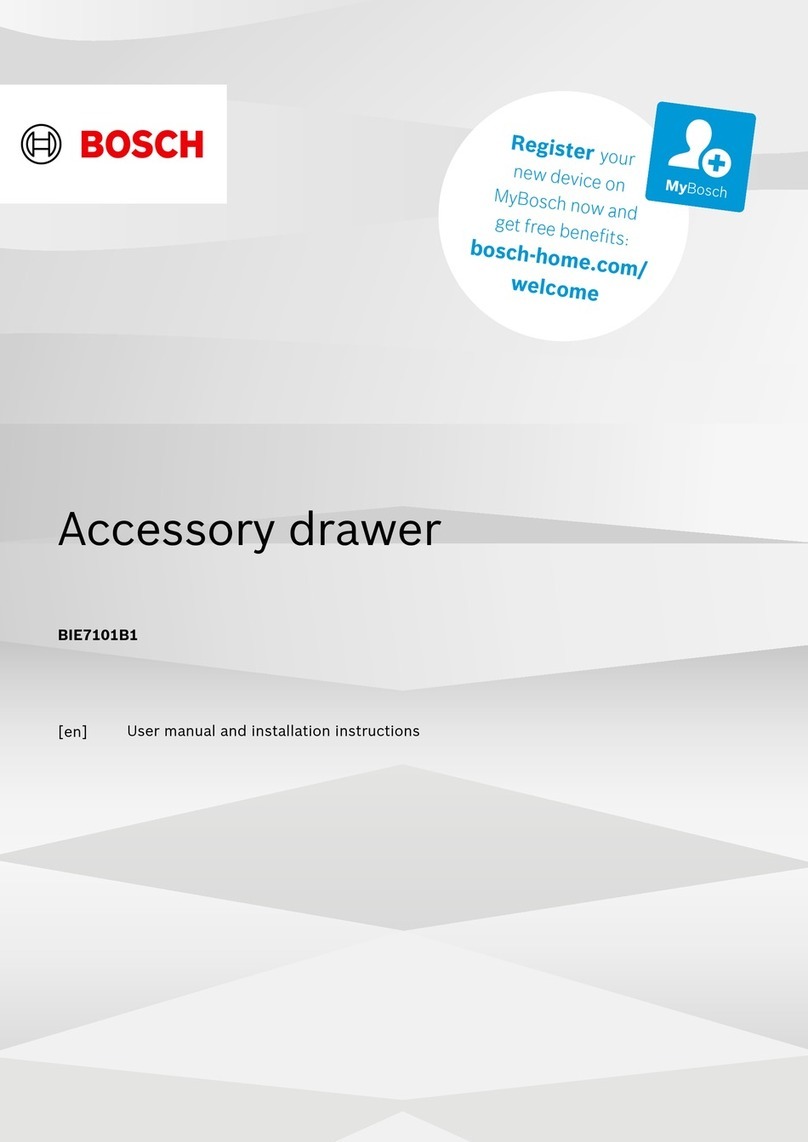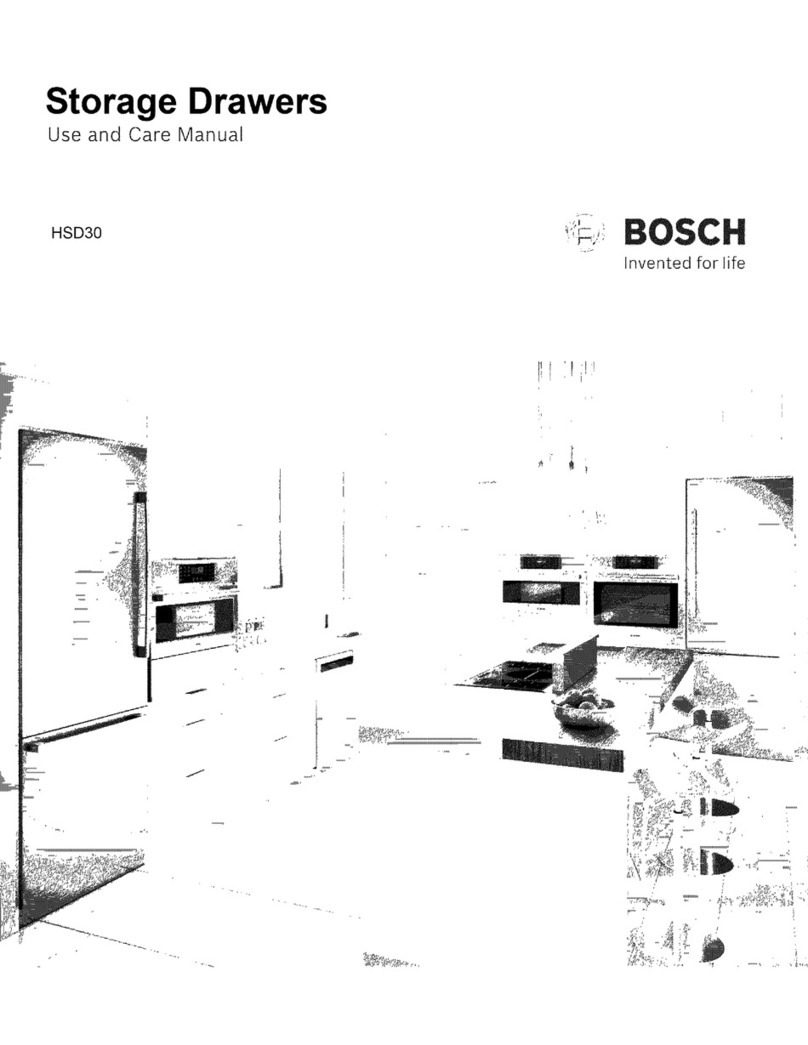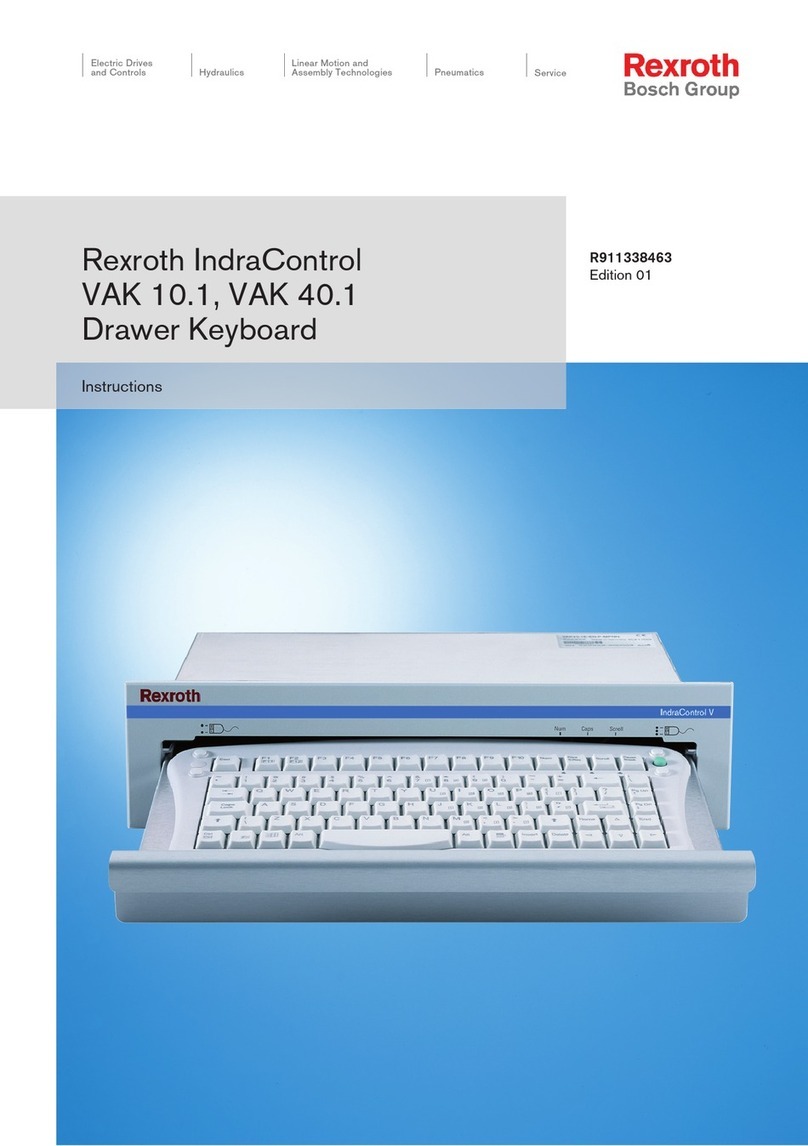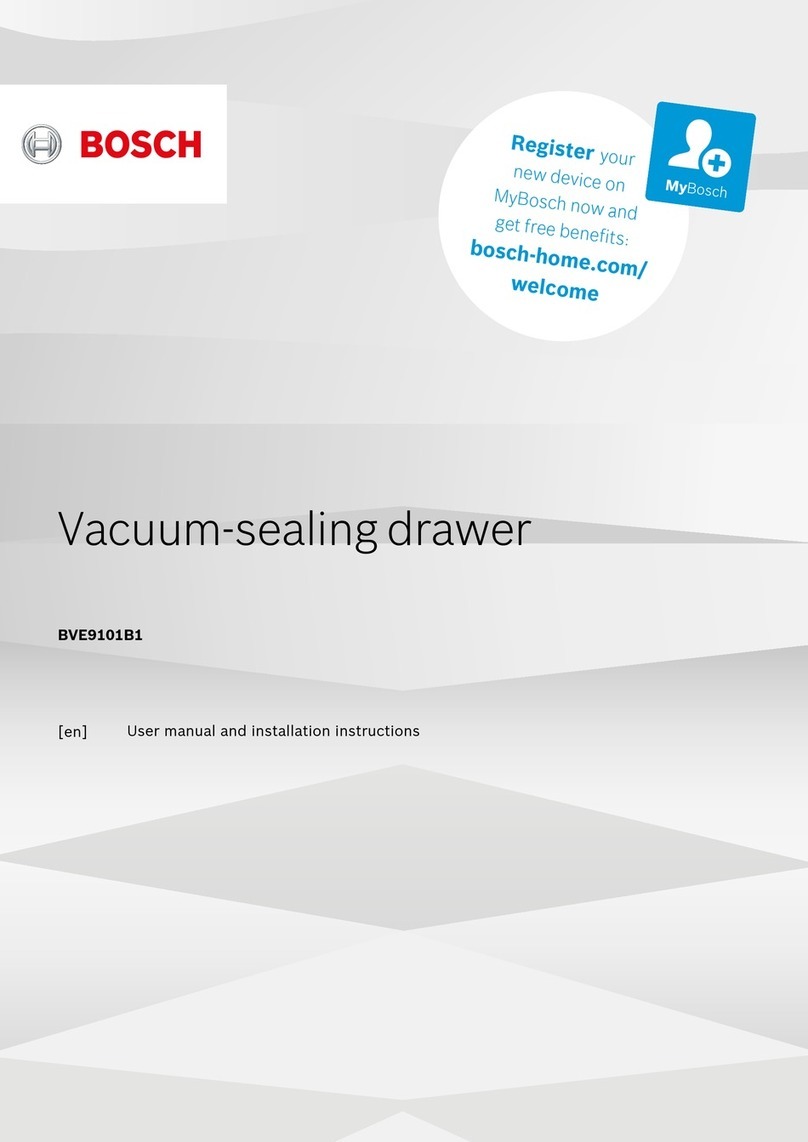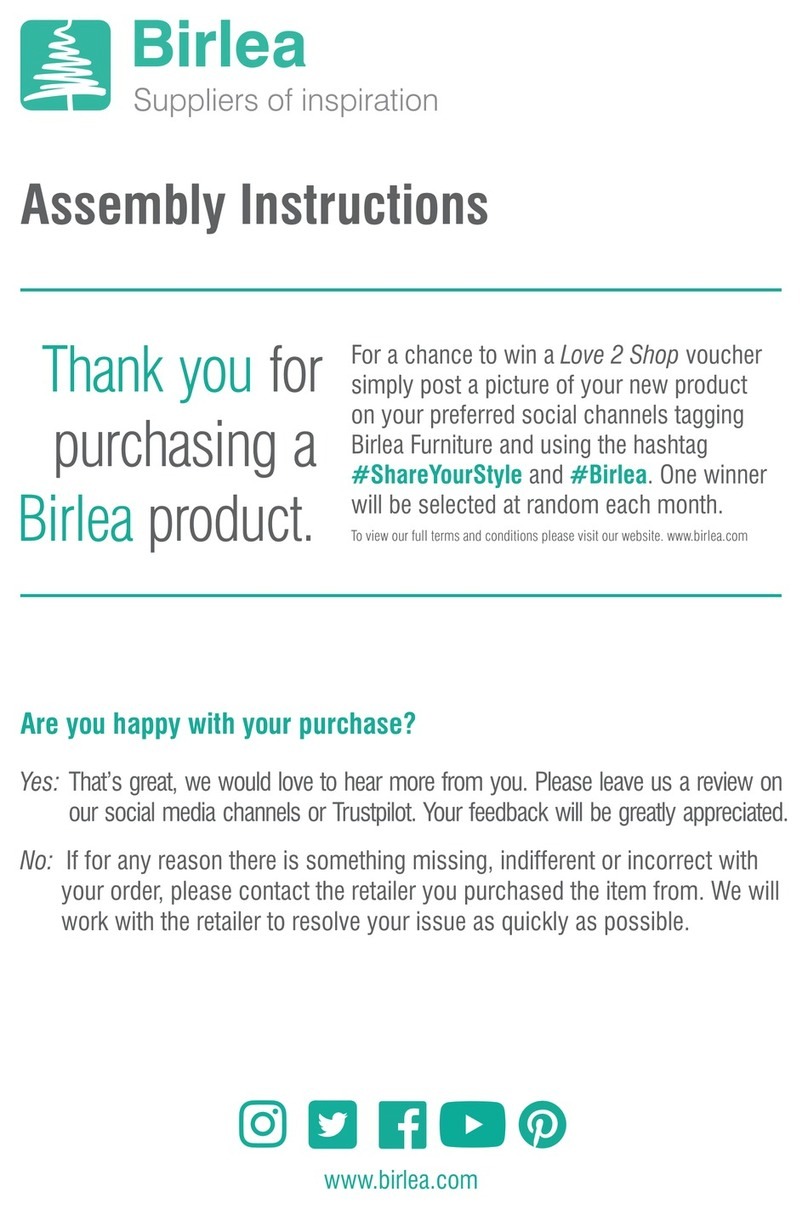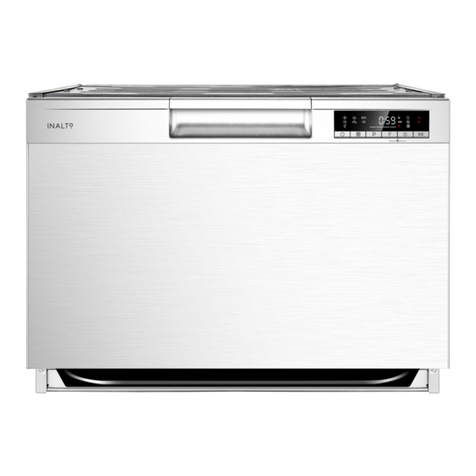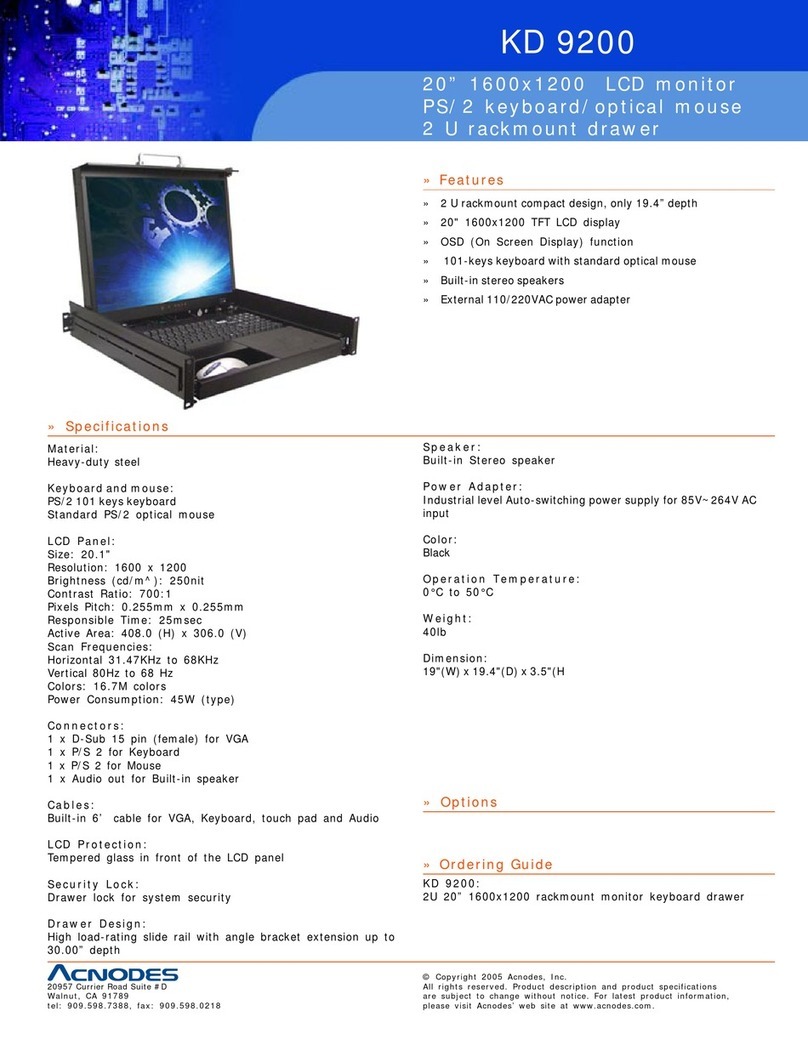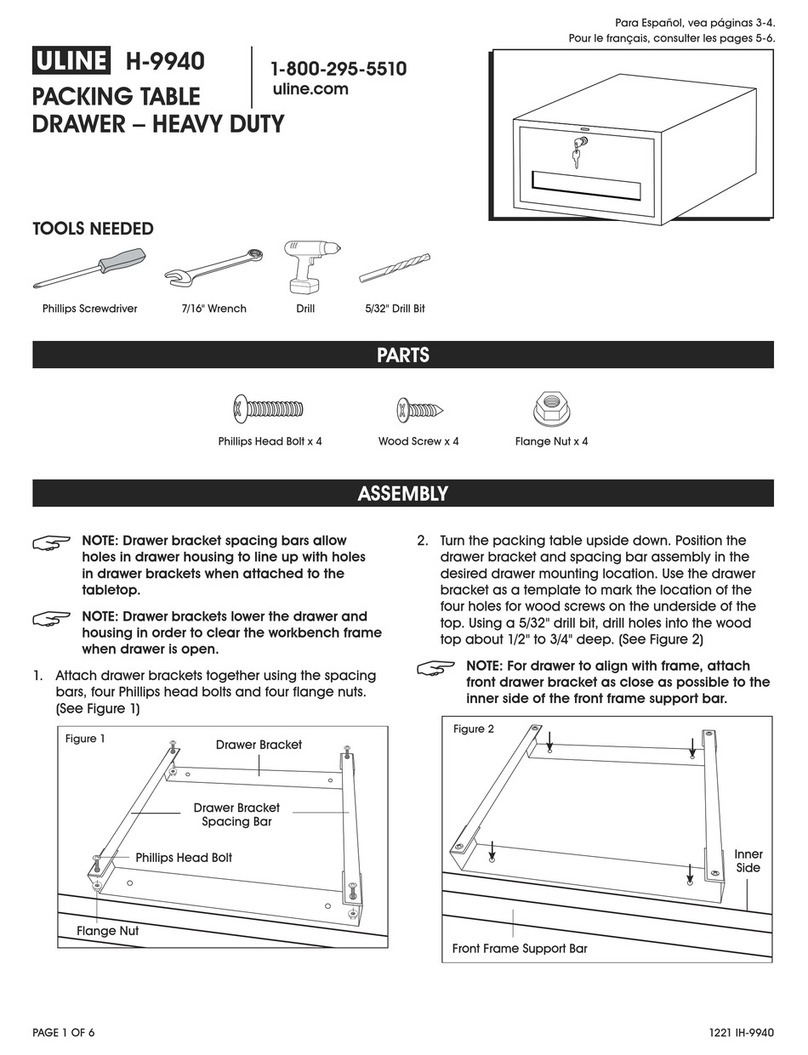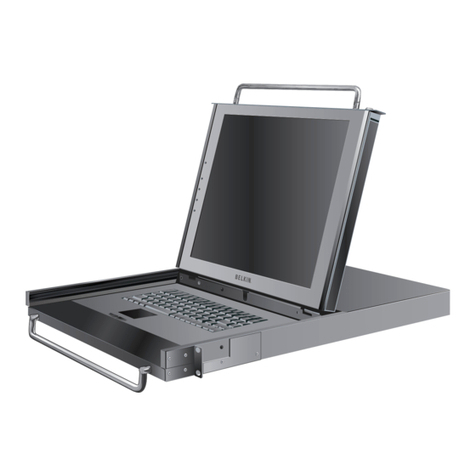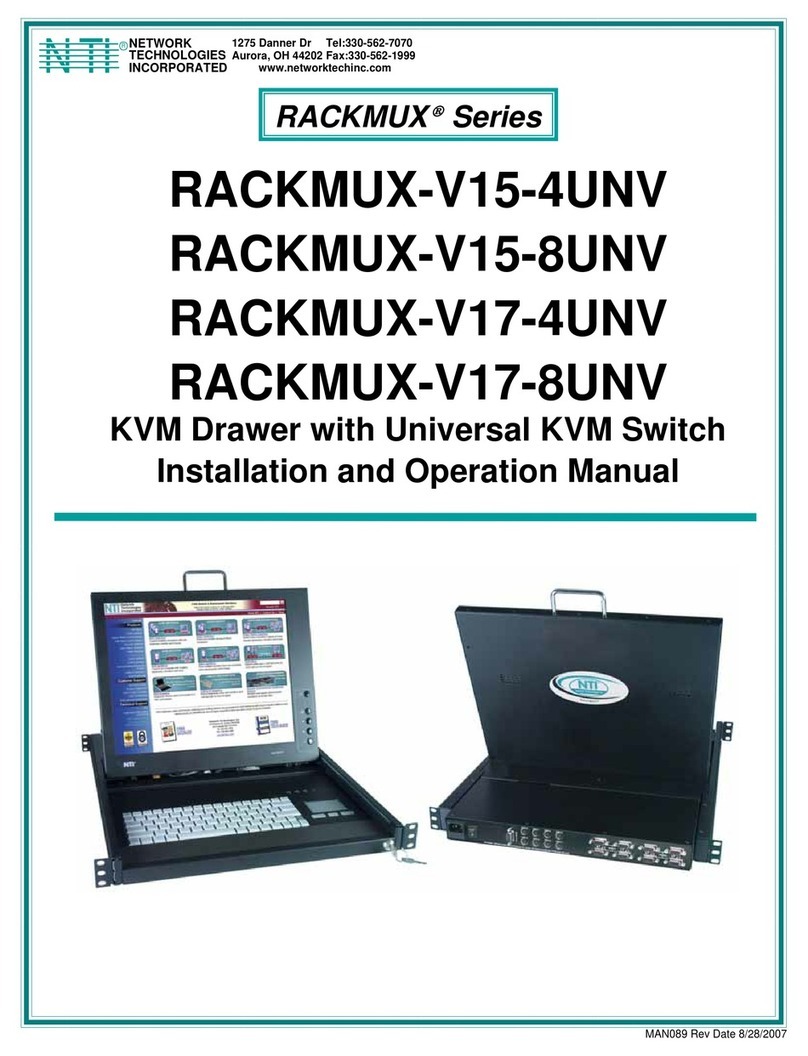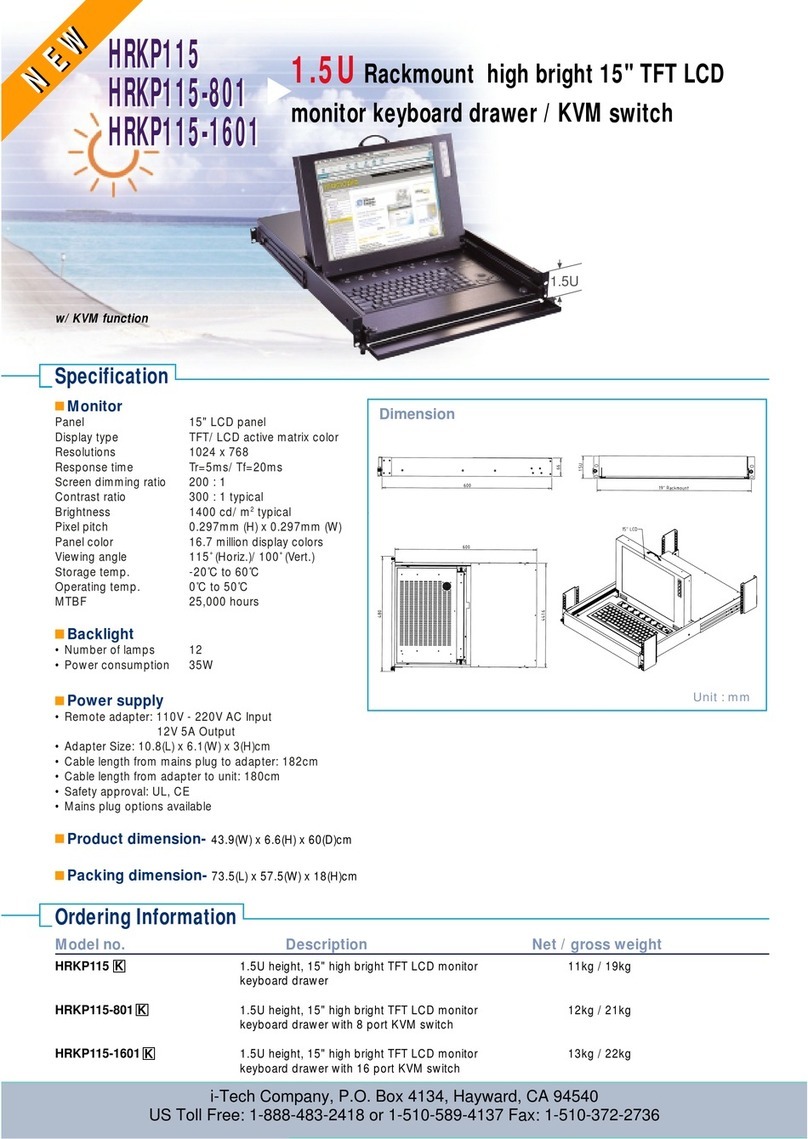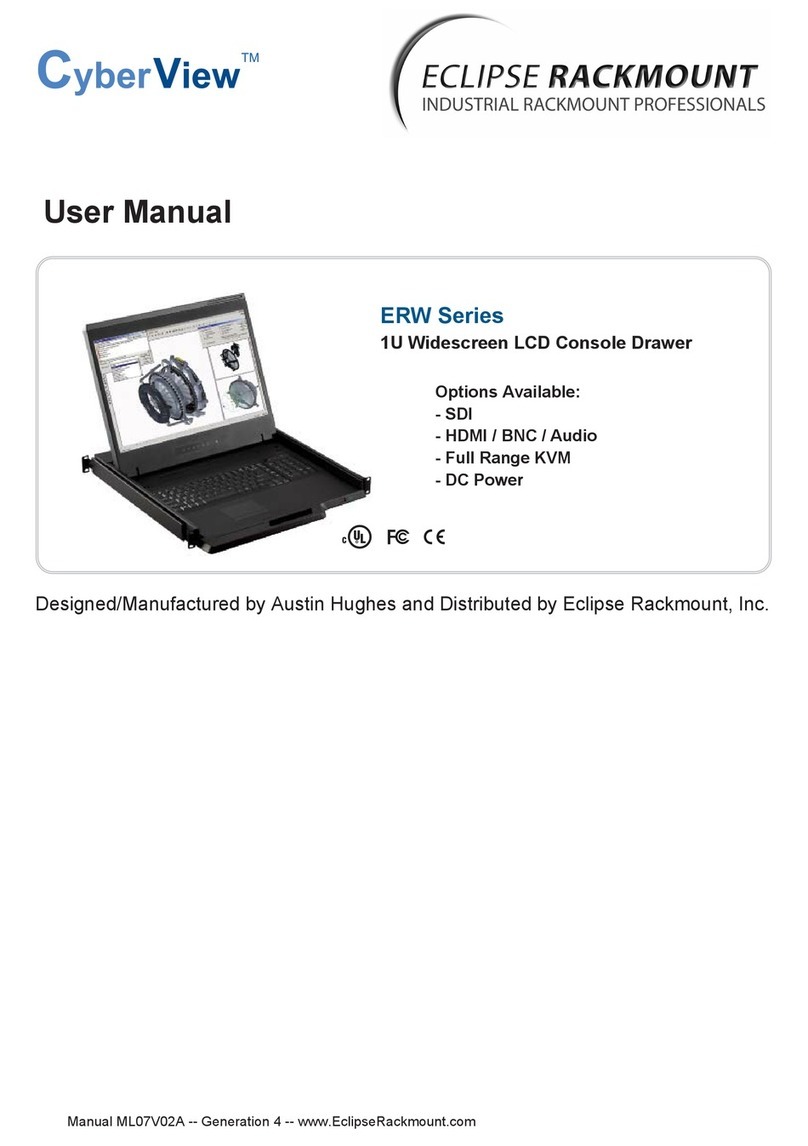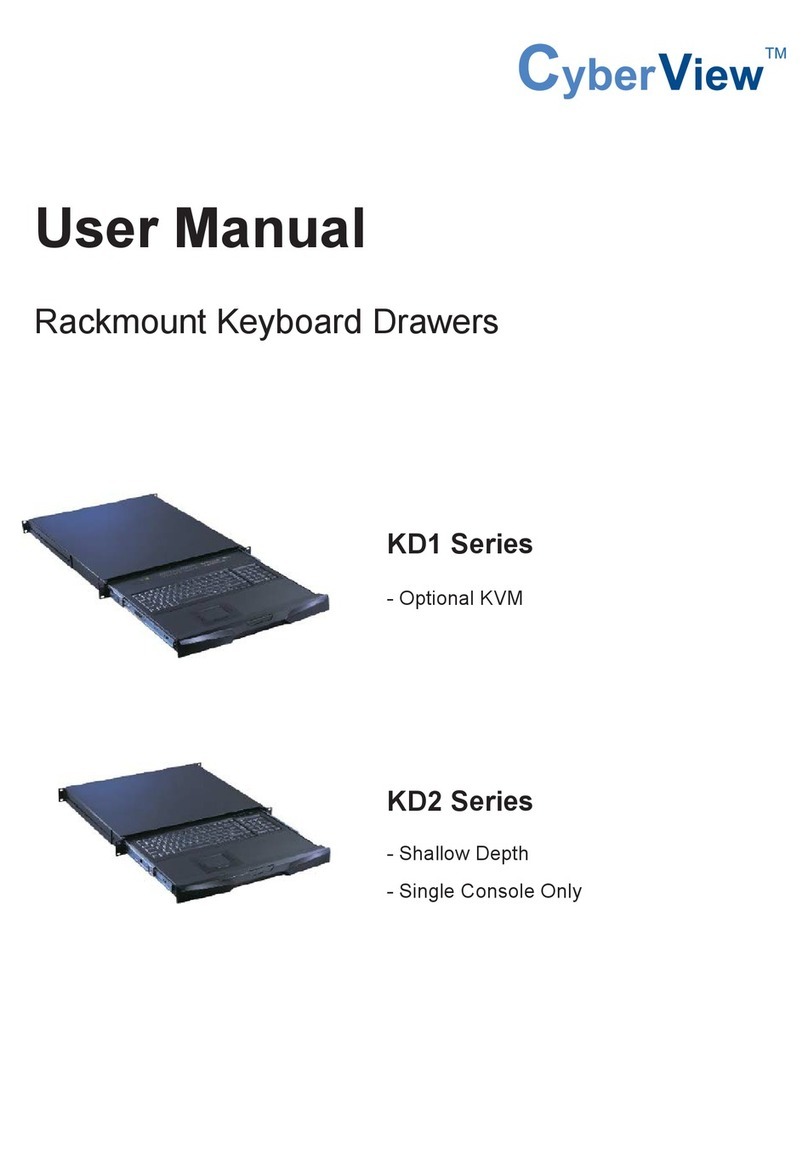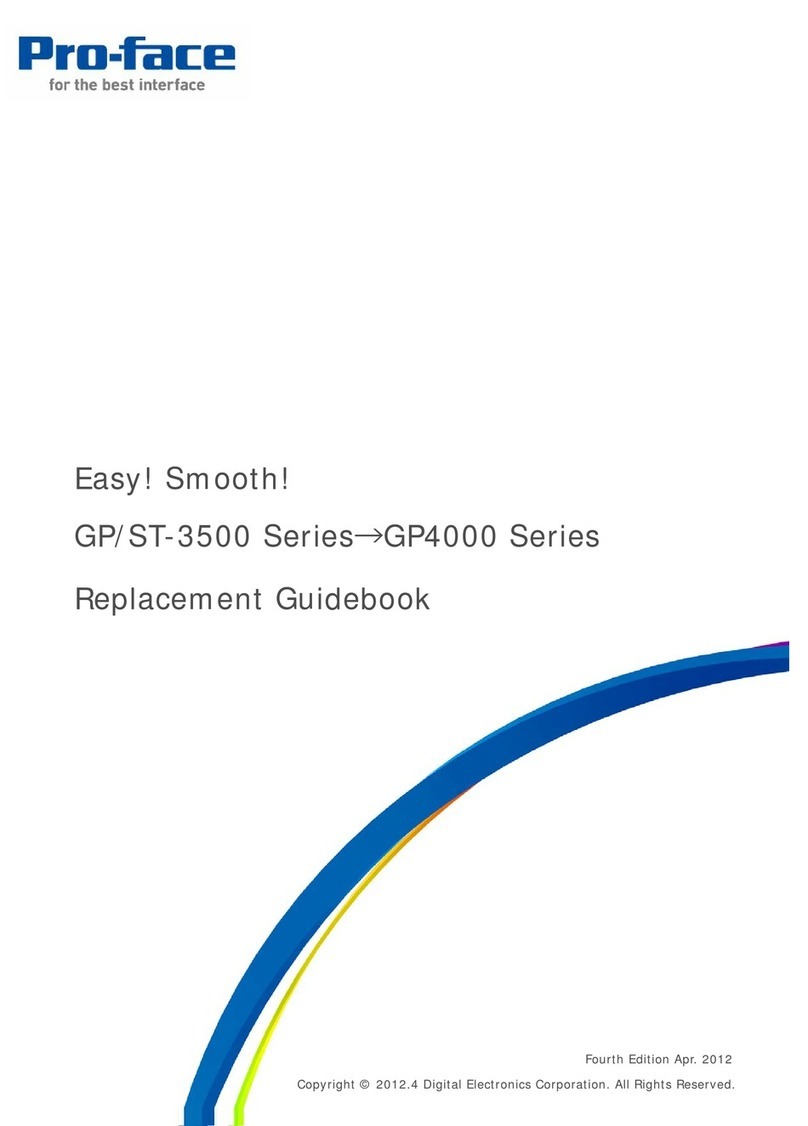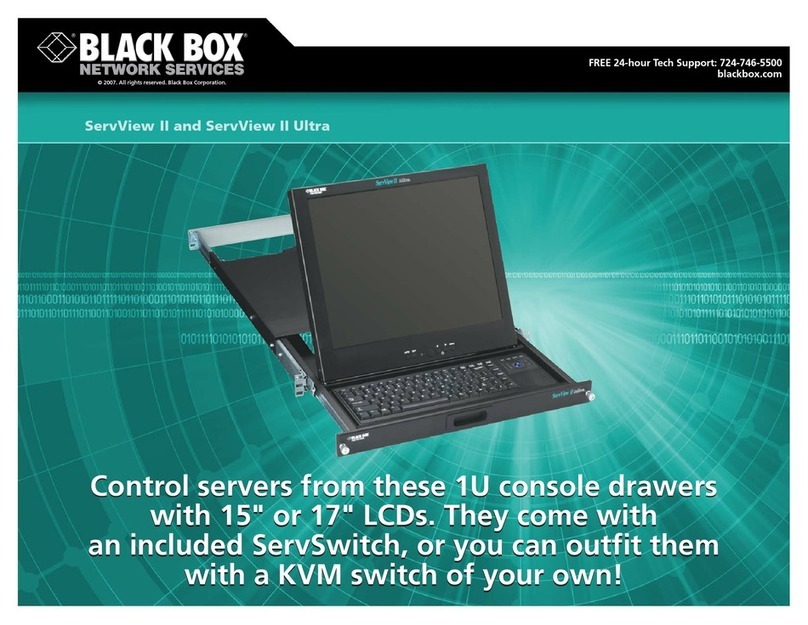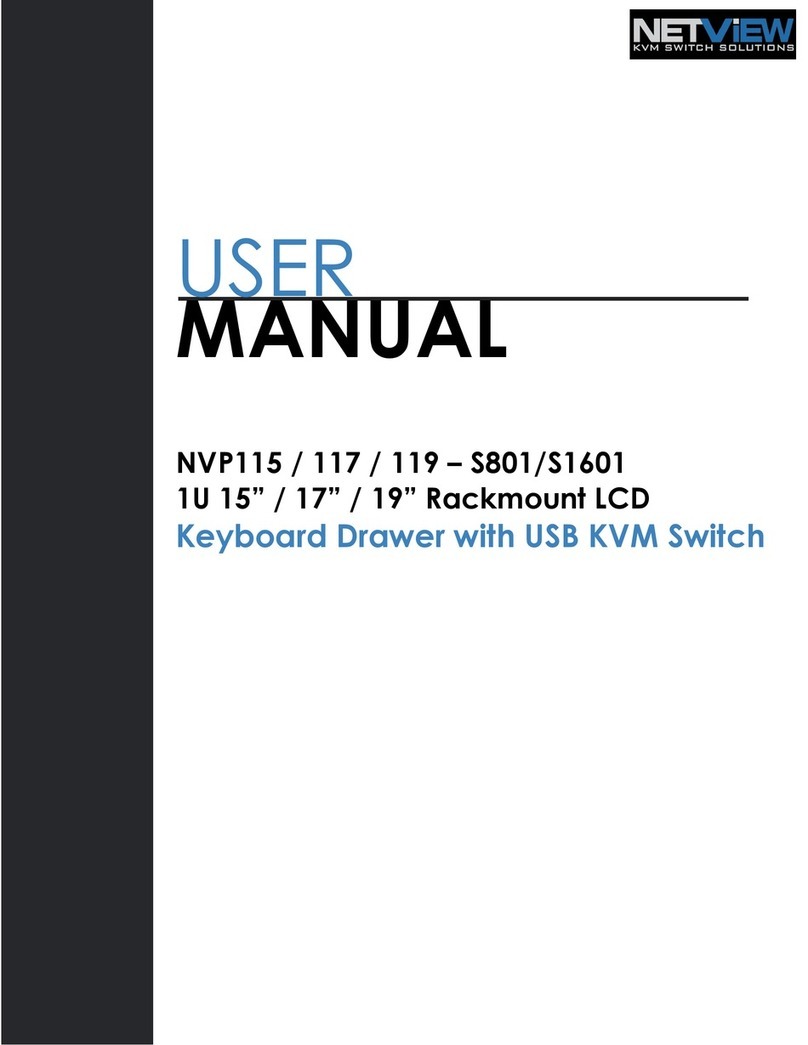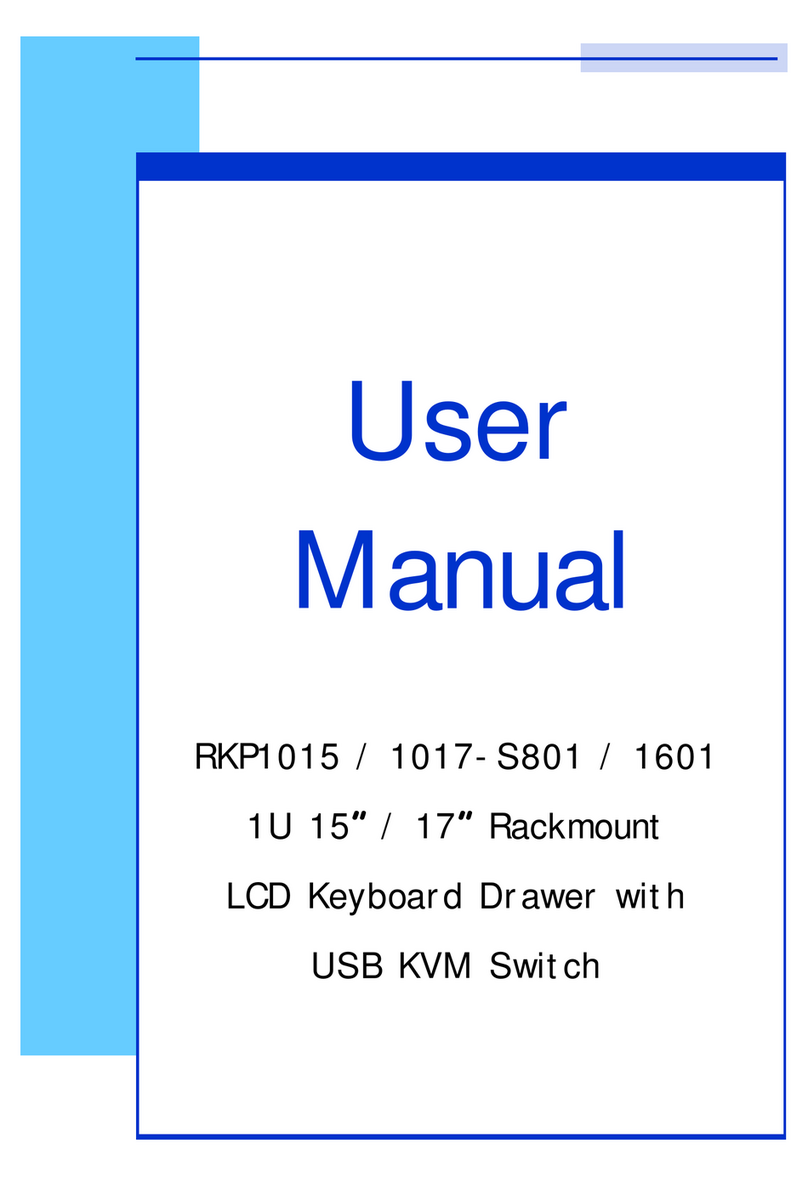Bosch BVE810NC0 Specification sheet

en Safety
2
Table of contents
1 Safety ...................................................................2
2 Avoiding material damage..................................3
3 Environmental protection and saving en-
ergy ......................................................................4
4 Familiarising yourself with your appliance .......4
5 Accessories.........................................................5
6 Basic operation ...................................................5
7 Vacuum-sealing in the bag.................................6
8 Vacuum-sealing in the container .......................7
9 Drying ..................................................................8
10 Cleaning and servicing.......................................8
11 Troubleshooting..................................................9
12 How it works......................................................11
13 Disposal.............................................................13
14 Customer Service..............................................13
1 Safety
Observe the following safety instructions.
1.1 General information
¡Read this instruction manual carefully.
¡Keep the instruction manual and the
product information safe for future refer-
ence or for the next owner.
¡Do not connect the appliance if it has been
damaged in transit.
1.2 Intended use
This appliance is only intended to be fully fit-
ted in a kitchen.
Only a licensed professional may connect ap-
pliances without plugs. Damage caused by in-
correct connection is not covered under the
warranty.
Only use this appliance:
¡To vacuum-seal food in suitable vacuum-
sealing bags or containers and to heat-seal
film.
¡In private households and in enclosed
spaces in a domestic environment.
¡Up to an altitude of max. 4000m above
sea level.
1.3 Restriction on user group
This appliance may be used by children aged
8 or over and by people who have reduced
physical, sensory or mental abilities or inad-
equate experience and/or knowledge,
provided that they are supervised or have
been instructed on how to use the appliance
safely and have understood the resulting
dangers.
Do not let children play with the appliance.
Children must not perform cleaning or user
maintenance unless they are at least 15 years
old and are being supervised.
Keep children under the age of 8 years away
from the appliance and power cable.
1.4 Safe use
WARNING‒Risk of burns!
The heat-sealing bar in the vacuum-sealing
compartment becomes extremely hot if the
appliance is used frequently and there are
long heat-sealing times.
▶Never touch the hot heat-sealing bar.
▶Keep children at a safe distance.
WARNING‒Risk of electric shock!
An ingress of moisture can cause an electric
shock.
▶Do not use steam- or high-pressure clean-
ers to clean the appliance.
If the appliance or the power cord is dam-
aged, this is dangerous.
▶Never operate a damaged appliance.
▶Never operate an appliance with a cracked
or fractured surface.
▶Never pull on the power cord to unplug the
appliance. Always unplug the appliance at
the mains.
▶If the appliance or the power cord is dam-
aged, immediately unplug the power cord
or switch off the fuse in the fuse box.
▶Call customer services. →Page13
Incorrect repairs are dangerous.
▶Repairs to the appliance should only be
carried out by trained specialist staff.
▶Only use genuine spare parts when repair-
ing the appliance.
▶If the power cord of this appliance is dam-
aged, it must be replaced by the manufac-
turer, the manufacturer's Customer Service
or a similarly qualified person in order to
prevent any risk.

Avoiding material damage en
3
WARNING‒Risk of fire!
The heat-sealing bar in the vacuum-sealing
compartment becomes extremely hot. Com-
bustible vapours may ignite.
▶Do not vacuum-seal any combustible li-
quids in the vacuum-sealing bag.
▶Do not store any combustible materials and
objects inside the appliance.
WARNING‒Risk of injury!
The smallest cracks in the glass lid may result
in it imploding when the vacuum is attached.
▶Unplug the appliance from the mains or
switch off the circuit breaker in the fuse
box.
▶Call after-sales service.
Any misuse of the vacuum-sealing drawer
may lead to injury.
▶Do not insert any hoses that are connected
to the appliance into any body cavities.
▶Do not vacuum-seal any living animals.
WARNING‒Risk of harm to health!
During the vacuuming process, the vacuum-
sealing compartment and the glass lid de-
form. The protective layer on the glass may
be damaged and the glass lid may break.
▶Screw-top jars, other hard containers, and
non-deformable food that are vacuum-
sealed in the compartment when the lid is
closed must not come into contact with this
lid.
▶Hard containers and non-deformable food
must not protrude over a maximum height
of 80mm.
WARNING‒Risk of suffocation!
Children may put packaging material over
their heads or wrap themselves up in it and
suffocate.
▶Keep packaging material away from chil-
dren.
▶Do not let children play with packaging ma-
terial.
Children may breathe in or swallow small
parts, causing them to suffocate.
▶Keep small parts away from children.
▶Do not let children play with small parts.
2 Avoiding material damage
ATTENTION!
Damage to the appliance may affect the safety consid-
erably.
▶Check the appliance for damage before each use.
▶Check that the glass lid is intact.
▶Never use a damaged appliance.
▶Call after-sales service.
Using the appliance carelessly may cause damage to
the appliance.
▶Open and close the glass lid slowly.
▶Do not place any objects on the glass lid.
▶Do not use the appliance as a work surface or stor-
age space.
▶Do not let any objects fall onto the glass lid.
▶Pull the drawer out completely during use.
▶After use, close the drawer completely.
Foreign objects in the vacuum-sealing compartment
damage the appliance.
▶Before closing the glass lid, ensure that there is no
debris in the vacuum-sealing compartment.
If the seal is sitting incorrectly or is damaged, this im-
pairs the function of the appliance and may damage
the appliance.
▶Check that the seal is positioned correctly on the
glass lid.
▶The seal's contact surface must be clean and free
from debris.
▶Do not damage the seal with pointed or sharp ob-
jects.
▶Never operate an appliance with a defective seal.
▶If a seal is defective, contact after-sales service.
Using tools to open the glass lid damages the appli-
ance.
▶In the event of a power cut during the vacuum-seal-
ing process, wait until the power supply is restored.
The vacuum in the vacuum-sealing compartment is
retained. Restart the vacuum-sealing process.
Escaping steam caused by boiling at excessive tem-
peratures may lead to malfunctions.
▶Only use bags that are suitable for vacuum-sealing
food.
▶Do not use any sales packages that have already
been opened.
▶Process the food that is to be vacuum-sealed at an
output temperature of 1–8°C.
▶Do not vacuum-seal liquids in the vacuum-sealing
bag at the highest level. Use vacuum-sealing
level2.
▶Heat-seal the bag if you notice an intensified forma-
tion of bubbles.

en Environmental protection and saving energy
4
3 Environmental protection and saving energy
3.1 Disposing of packaging
The packaging materials are environmentally compat-
ible and can be recycled.
▶Sort the individual components by type and dispose
of them separately.
4 Familiarising yourself with your appliance
4.1 Function
During the vacuum-sealing process, air is pumped out
of the vacuum-sealing compartment and the bag.
This produces a high vacuum in the compartment. The
higher the vacuum-sealing level, the less air remains in
the compartment and the bag, and the higher the pres-
sure difference to the environment.
Once the selected vacuum-sealing level has been
reached, the heat-sealing bar is pressed against the sil-
icone bar on the glass lid. During this, the bag is heat-
sealed.
After a short cooling time, air flows back into the com-
partment, creating a loud noise. During this process,
the bag suddenly contracts and encloses the food. The
drawer's glass lid then opens.
4.2 Appliance
You can find an overview of the parts of your appliance
here.
1
2
3
4
1
Glass lid
2
Air outlet
3
Heat-sealing bar
4
Vacuum-sealing compartment
4.3 Controls
You can use the control panel to configure all functions
of your appliance and to obtain information about the
operating status.
Sym-
bol
Meaning Explanation
Switching on
Switching off
Switching on the appli-
ance
Switching off the appli-
ance
Vacuum-sealing
level
Selecting the vacuum-
sealing level
Sym-
bol
Meaning Explanation
Heat-sealing time Selecting a heat-sealing
time
Heat-seal the vacuum-
sealing bag early
Start Starting the vacuum-seal-
ing process

Accessories en
5
Sym-
bol
Meaning Explanation
Stop Cancelling the vacuum-
sealing process
Dry Drying the pump
Note Referring to the fault table
4.4 Vacuum-sealing levels
The vacuum-sealing levels 1 to 3 achieve different de-
grees of vacuum.
When vacuum-sealing in the container, the degrees of
vacuum are lower and therefore better suited for the
particular food. When the external vacuum-sealing ad-
aptor is attached, the vacuum-sealing drawer automat-
ically detects which mode has just been activated.
Vacuum-sealing levels 1 2 3
Vacuum-sealing in the bag 80% 95% 99%
Vacuum-sealing containers
and bottles
50% 75% 90%
5 Accessories
Use original accessories. These have been made especially for your appliance.
Accessories Property Use
External vacuum-sealing
adapter
Vacuum-sealing containers or bottles.
Vacuum hose Connect the external vacuum-sealing adapter
to the vacuum-sealing container or the bottle
adaptor.
Vacuum-sealing bag 180x280mm (50 pcs)
240 x 350mm (50 pcs)
5.1 Other accessories
You can purchase other accessories from our after-
sales service, specialist retailers or online.
You will find a comprehensive range of products for
your appliance in our brochures and online:
www.bosch-home.com
Accessories vary from one appliance to another. When
purchasing accessories, always quote the exact
product number (E no.) of your appliance.
You can find out which accessories are available for
your appliance in our online shop or from our after-
sales service.
Other accessories Specialist retailer order number After-sales service order number
Vacuum-sealing bag 180x280mm
(100 pcs)
HEZ66D910 17002081
Vacuum-sealing bag 240 x 350mm
(100pcs)
HEZ66D920 17002082
6 Basic operation
6.1 Opening the appliance
1. Press on the centre of the drawer front.
aThe vacuum-sealing drawer pops out gently.
2. Reach in and pull out the vacuum-sealing drawer by
the edge.
6.2 Closing the appliance
▶Touch the middle of the vacuum-sealing drawer and
push it back.
6.3 Switching on the appliance
▶Press .
6.4 Switching off the appliance
If you do not perform any actions on the appliance for
10minutes, the appliance automatically switches off.
▶Press .

en Vacuum-sealing in the bag
6
7 Vacuum-sealing in the bag
In the bag, vacuum-sealed food has a longer shelf life.
You can therefore marinate the food or prepare for
sous-vide cooking.
7.1 Suitable vacuum-sealing bags
Use suitable vacuum-sealing bags in order to achieve
an optimum result.
Use the original vacuum-
sealing bags that are en-
closed with the appliance
or can be ordered as ac-
cessories.
¡These bags are suit-
able for a temperature
range of -40°C–
100°C.
¡The optimum heat-
sealing time for these
bags is level 2.
¡The bags are suitable
for use in the mi-
crowave. Pierce the
bags before you heat
them up in the mi-
crowave.
Only use bags that are
suitable for vacuum-seal-
ing food.
Commercially available
products are different
when it comes to the
quality of the food, tem-
perature resistance, ma-
terial and surface.
The heat-sealing time for
the vacuum-sealing bag
always depends on the
material from which it is
made.
¡Thin-walled bag: Heat-
sealing level1
¡Thicker material: Heat-
sealing level2 or
higher
Use bags with a max-
imum width of 240mm.
The length of the heat-
sealing bar limits the size
of the vacuum-sealing
bag that can be used.
7.2 Filling the bag
Requirements
¡The edge of the bag is clean and dry.
¡There is no food residue around the edge of the bag
in the area around the seam.
1. Fold over the edge of the bag by approx. 3cm.
2. Where possible, position the items of food in the va-
cuum-sealing bag next to each other.
3. Fold the edge of the bag back.
Tip:To ensure that you can keep track of your bags
and the food that is vacuum-sealed within them, make
a note on the bag of the date of the vacuum-sealing
along with the contents.
7.3 Vacuum-sealing in the bag
Requirement:The initial temperature of the food is
ideally in the range of 1–8°C.
1. Open the glass lid.
2. Place the vacuum-sealing bag in the compartment.
3. Make sure that the air outlet is not covered so that
the pump can extract the air from the compartment.
4. To ensure that the heat-sealing seam is perfectly
closed, make sure that the centre of the bag and
the ends of the bag are lying flat on top of each
other on the heat-sealing bar.
5. Make sure that the open end of the bag is protrud-
ing over the heat-sealing bar by approx. 3cm but
that it is not touching the lid seal.

Vacuum-sealing in the container en
7
6. Elevate the bag if necessary using an item such as
a chopping board to prevent the bag from sliding
down.
7. Touch to select the vacuum-sealing level.
8. Touch to select the heat-sealing time.
9. Tightly close the glass lid and hold it there for a few
seconds.
10. Touch to start the vacuum-sealing process.
aThe vacuum-sealing process starts. The vacuum-
sealing level indicators pulsate in orange one after
the other until the selected value has been reached.
aThe heat-sealing process starts. The vacuum-sealing
level indicators pulsate in orange one after the other
until the selected level has been reached.
aThe vacuum-sealing process can take up to
twominutes.
aAt the end of the process, the compartment is ventil-
ated. An audible signal sounds.
11. Once the vacuum-sealing process is finished, open
the glass lid.
12. WARNING‒Risk of burns!
The heat-sealing bar in the vacuum-sealing compart-
ment becomes extremely hot if the appliance is
used frequently and there are long heat-sealing
times.
▶Never touch the hot heat-sealing bar.
▶Keep children at a safe distance.
Remove the heat-sealed vacuum-sealing bag from
the compartment.
13. After vacuum-sealing, check the heat-sealing seam
on the bag.
‒Carefully pull the seam apart.
‒If the seam does not stay together, select a
higher heat-sealing level.
‒If the seam is deformed, select a lower heat-seal-
ing level or leave the appliance to cool down.
Note:If you vacuum-seal food in bags several times in
succession, the heat-sealing bar becomes increasingly
hotter. This may impair the quality of the heat-sealing
seam. After several vacuum-sealing processes, select a
lower heat-sealing time or leave the appliance to cool
for approx. twominutes between the processes.
7.4 Early heat-sealing
Use this function if you only want to pack your delicate
food in a bag so that it is air-tight, without the contents
sitting too tightly against the bag.
1. To stop the vacuum-sealing process and heat-seal
the bag early, touch .
aThe appliance displays the vacuum-sealing level un-
til it is reached.
aAt the end of the process, the compartment is ventil-
ated.
aAn audible signal sounds.
2. Open the glass lid.
3. Remove the heat-sealed vacuum-sealing bag from
the compartment.
Note:To heat-seal the bag, the vacuum-sealing drawer
requires a specific degree of vacuum.
If you touch first, the vacuum-sealing drawer pumps
air out of the compartment until this degree has been
reached. The bag is then heat-sealed.
7.5 Cancelling the vacuum-sealing process
in the bag
1. To cancel the vacuum-sealing process early, touch
.
aThe appliance displays the vacuum-sealing level un-
til it is reached.
aThe bag is not heat-sealed.
aThe lid opens slightly and the compartment is ventil-
ated.
aAn audible signal sounds.
2. Remove the vacuum-sealing bag from the compart-
ment.
8 Vacuum-sealing in the container
In the container, vacuum-sealed food has a longer shelf
life.
8.1 Vacuum-sealing in the container
Vacuum-seal the food in a suitable vacuum-sealing
container in order to preserve the food for longer.
1. Open the glass lid.
2. Plug the vacuuming adaptor into the air outlet.
3. Secure the hose to the vacuuming adaptor and the
vacuum-sealing container.

en Drying
8
4. Touch to select the vacuum-sealing level.
5. Touch to start the vacuum-sealing process.
aThe vacuum-sealing process starts. The vacuum-
sealing level indicators pulsate in orange one after
the other until the selected value has been reached.
aThe vacuum-sealing process can take up to
twominutes.
aThe vacuum-sealing level that has been reached
lights up and an audible signal sounds.
6. Detach the hose from the container and the external
vacuuming adaptor.
Note:If larger bubbles form, cancel the vacuum-sealing
process. →Page8
8.2 Suitable vacuum-sealing containers
Use suitable vacuum-sealing containers in order to
achieve an optimal result.
Only use containers that
are suitable for vacuum-
sealing food.
Commercially available
products are different
when it comes to the
quality of the food and the
material.
The vacuum hose at-
tached to this appliance
has an internal diameter
of 3mm.
You may need an adapter
for your container so that
the hose fits. These ad-
aptors are often already
included with the vacuum-
sealing containers.
8.3 Cancelling the vacuum-sealing in the
container
1. To cancel the vacuum-sealing process early, touch
.
aThe appliance displays the vacuum-sealing level un-
til it is reached.
2. Detach the hose from the container and the external
vacuuming adaptor.
9 Drying
When vacuum-sealing food, the smallest volume of wa-
ter gets into the vacuum pump system.
This effect is exacerbated when you are vacuum-seal-
ing liquids or extremely moist food. For this reason, the
appliance comes with a drying function, which further
removes any liquid that collects in the pump.
¡If the symbol lights up white, it is advisable to run
a drying cycle. However, at this point, you can con-
tinue to use the appliance as normal if you wish.
¡If the symbol lights up red, you must run a drying
cycle.
9.1 Starting drying
Note:You can close the vacuum-sealing drawer while
drying is in progress.
1. Tightly close the glass lid and hold it there.
2. Touch .
aThe drying starts and takes between 5 and 20
minutes.
aDuring the procedure, pulsates in red.
aAt the end of the process, the compartment is ventil-
ated and an audible signal sounds.
aYou can now open the glass lid.
3. Note:Occasionally, a single drying procedure is not
sufficient. If, after one drying procedure, and
red light up, there is still moisture in the pump
system.
Wait until goes out.
4. Restart the drying process.
10 Cleaning and servicing
To keep your appliance working efficiently for a long
time, it is important to clean and maintain it carefully.
10.1 Cleaning products
You can obtain suitable cleaning products from after-
sales service or the online shop.
ATTENTION!
Unsuitable cleaning products may damage the sur-
faces of the appliance.
▶Do not use harsh or abrasive detergents.
▶Do not use cleaning products with a high alcohol
content.
▶Do not use hard scouring pads or cleaning
sponges.
▶Do not use any special cleaners for cleaning the ap-
pliance while it is hot.
▶Only use glass cleaners, glass scrapers or stainless
steel care products if recommended in the cleaning
instructions for the relevant part.
▶Wash sponge cloths thoroughly before use.
10.2 Cleaning the appliance
WARNING‒Risk of burns!
The heat-sealing bar in the vacuum-sealing compart-
ment becomes extremely hot if the appliance is used
frequently and there are long heat-sealing times.
▶Never touch the hot heat-sealing bar.
▶Keep children at a safe distance.

Troubleshooting en
9
WARNING‒Risk of electric shock!
An ingress of moisture can cause an electric shock.
▶Do not use steam- or high-pressure cleaners to
clean the appliance.
Requirements
¡The appliance is switched off.
¡Ensure that the heat-sealing bar in the vacuum-seal-
ing compartment has cooled down.
1. Clean the appliance with a damp cloth and neutral
cleaning agents, such as washing-up liquid and wa-
ter.
During cleaning, ensure that no water or other liquid
gets into the vacuum-sealing compartment or, in
particular, into the vacuum pump's air outlet.
Never spray the inside or outside of the appliance
with water.
2. Leave the appliance and accessory parts to fully dry
after they have been cleaned.
10.3 Cleaning the glass front and glass lid
▶Clean the glass front and the glass lid with glass
cleaner and a soft cloth.
Do not use any abrasive sponges that may scratch
or any glass scrapers.
10.4 Cleaning the stainless steel vacuum-
sealing compartment
1. Always remove limescale, grease, starch or albumin
stains immediately. Corrosion can form under such
stains.
2. Clean with water and some washing-up liquid.
3. Dry with a soft cloth.
10.5 Cleaning the plastic control panel
▶Clean the control panel using a soft cloth.
Do not use any abrasive sponges that may scratch
or any glass scrapers.
10.6 Cleaning the heat-sealing bar
ATTENTION!
Cleaning in the dishwasher leads to damage.
▶Never clean the appliance components in the dish-
washer.
1. Remove the remaining film from the heat-sealing
bar.
2. Never use abrasive cleaning agents to clean the
heat-sealing bar.
3. Dry with a soft cloth.
10.7 Cleaning the accessories
ATTENTION!
Cleaning in the dishwasher leads to damage.
▶Never clean the appliance components in the dish-
washer.
1. Clean using a sponge cloth and hot soapy water in
the direction of the finish.
2. Dry with a soft cloth.
11 Troubleshooting
You can rectify minor faults on your appliance yourself.
Read the troubleshooting information before contacting
after-sales service. This will avoid unnecessary costs.
WARNING‒Risk of injury!
Improper repairs are dangerous.
▶Repairs to the appliance should only be carried out
by trained specialist staff.
▶If the appliance is defective, call Customer Service.
WARNING‒Risk of electric shock!
Incorrect repairs are dangerous.
▶Repairs to the appliance should only be carried out
by trained specialist staff.
▶Only use genuine spare parts when repairing the
appliance.
▶If the power cord of this appliance is damaged, it
must be replaced by the manufacturer, the manufac-
turer's Customer Service or a similarly qualified per-
son in order to prevent any risk.
11.1 Malfunctions
Fault Cause and troubleshooting
The vacuum-sealing
process will not start.
does not appear
even though the lid is
closed.
The door switch on the glass lid is missing or is not detected by the appliance.
▶Call the after-sales service.
→"Customer Service", Page13

en Troubleshooting
10
Fault Cause and troubleshooting
If you try to operate
the appliance several
times in succession,
the vacuum-sealing
process seems to run
as normal but the
bag is not heat-
sealed.
The temperature protection switch for the heat-sealing transformer has tripped.
1. Allow the appliance to cool for at least 10minutes.
2. Allow the appliance to cool for at least twominutes between vacuum-sealing operations.
3. Restart the vacuum-sealing process.
The vacuum-sealing
process is taking
longer and longer.
There is too much moisture in the pump system.
▶Start the drying process.
→"Starting drying", Page8
The pump system is extremely hot.
1. Allow the appliance to cool down.
2. Restart the vacuum-sealing process.
The bag is defective,
which means that no
vacuum remains in
the vacuum-sealing
bag.
Sharp parts of the food (such as bones) may poke holes in the bag.
1. Check the bag for damage.
2. Use a different bag.
3. Place sharp-edged food that is to be vacuum-sealed in a bag so that you do not damage
the wall of the bag.
The heat-sealing
seam is defective,
which means that no
vacuum remains in
the vacuum-sealing
bag.
The selected heat-sealing time is unsuitable for the film jacket.
▶Select a different heat-sealing time.
There is liquid, grease or crumbs or creases along the heat-sealed seam.
1. Make sure that the bag is dry, that it has no creases, and that it is positioned fully on the
heat-sealing bar.
2. Use a different bag.
3. Fold over the edge of the bag by 3cm before you fill it.
The lid cannot be
opened.
A slight vacuum has formed and it is holding the lid closed.
1. Never use force to open the lid.
2. Initiate vacuum-sealing again and then cancel it immediately.
3. Unplug the appliance from the mains.
4. Start up the appliance again after 30seconds.
5. Touch for more than fiveseconds.
aThe appliance is reset.
11.2 Information on display panel
Fault Cause and troubleshooting
appears after a
few seconds.
The glass lid has not been closed properly.
1. Open and close the glass lid again.
2. When doing so, lightly press on the glass lid for the first few seconds.
The seal on the glass lid is not fitted properly or is defective.
▶Check the seal.
The seal on the glass lid has deformed.
▶Gently press the seal to straighten it out.
The lid on the external vacuum-sealing container has not been closed properly.
1. Check the position of the vacuum-sealing lid.
2. Only use suitable vacuum-sealing containers.
The external vacuum-sealing connection is not positioned correctly on the vacuum-sealing
compartment's air outlet.
▶Check the position of the vacuum-sealing lid.
appears after the
pump has been run-
ning for twominutes.
As the temperature rises, liquids begin to boil, meaning that the vacuum cannot be formed.
1. Only vacuum-seal cold liquids.
2. If the vacuum-sealing compartment is wet, wipe it dry.
3. Heat-seal the vacuum-sealing bag early if larger bubbles form.
4. Select a lower vacuum-sealing level.

How it works en
11
Fault Cause and troubleshooting
and light up
after the drying pro-
cess.
One drying process alone was not sufficient.
1. Wait until no longer lights up.
2. Repeat the drying process.
→"Starting drying", Page8
12 How it works
Here, you can find the ideal settings for various dishes
as well as the best accessories and cookware. We
have tailored these recommendations to your appli-
ance.
12.1 Vacuum-sealing for sous-vide cooking
You can use your vacuum-sealing drawer to prepare
food for sous-vide cooking. Sous-vide cooking is a
method of cooking "under a vacuum" at low temperat-
ures between 50–95°C and in 100% steam or in a
bain marie.
The vacuum-sealing drawer is used to heat-seal the
food in a special air-tight, heat-resistant cooking bag.
WARNING‒Risk of harm to health!
Sous-vide cooking is a method of cooking at low tem-
peratures and, if the instructions for use and hygiene
instructions are not adhered to, it may result adverse
health effects.
▶Only use high-quality, perfectly fresh food.
▶Wash and disinfect your hands.
▶Use disposable gloves, cooking tongs or grill tongs.
▶Take extra care when preparing critical food, such
as poultry, eggs and fish.
▶Always thoroughly rinse and peel fruit and veget-
ables.
▶Always keep work surfaces and chopping boards
clean.
▶Use different chopping boards for different types of
food.
▶Only interrupt the cold chain briefly to prepare the
food.
▶Store vacuum-sealed food in the refrigerator before
you starting the cooking process.
▶Once the food is cooked, consume it immediately.
Do not store it after cooking – not even in the refri-
gerator. It is not suitable for reheating.
Notes
¡Use the enclosed vacuum-sealing bags for sous-
vide cooking. You can reorder the vacuum-sealing
bags.
¡Do not cook the food in the bag in which you
bought it (e.g. portions of fish). These bags are not
suitable for sous-vide cooking.
¡Position the items of food in the bag next to each
other and not on top of each other.
Vacuum-sealing for sous-vide cooking
1. In order to achieve an even heat transfer and there-
fore a perfect cooking result, use the highest va-
cuum-sealing level to vacuum-seal food.
2. Before cooking the food, check whether the vacuum
in the bag is intact. To do this, refer to these points:
– There is no air in the vacuum-sealing bag.
– The heat-sealed seam is perfectly sealed.
– There are no holes in the vacuum-sealing bag.
Do not use a core temperature probe.
– Pieces of meat or fish that have been vacuum-
sealed together are not pressed directly against
one another.
– Vegetables and desserts are vacuum-sealed flat.
3. If the vacuum-sealing bag is not filled ideally, place
the food into a new bag and vacuum-seal it again.
Note:To prevent gases escaping from the food, e. g.
from vegetables, vacuum-seal the food no more than
one day before the cooking process. The gases pre-
vent the transfer of heat or cause the texture of the
food to change, thus altering how it cooks, as a result
of the vacuum pressure.
12.2 Fast marinating and flavouring
You can use your vacuum-sealing bag to quickly add
flavour to or marinate food such as meat, fruit and ve-
getables.
Marinating your food in the traditional way usually takes
a long time and is not particularly intensive. When you
vacuum-seal in a bag, the food's cell pores open. The
marinade that is added can be absorbed quickly. This
produces a more intensive taste in a much shorter
time.
12.3 Storing and transporting food
You can use the vacuum-sealing process to store your
food for longer and can benefit from additional advant-
ages.
¡Due to the low-oxygen environment in the vacuum,
freshly vacuum-sealed food remains edible for
longer when it is stored correctly.
¡The freezer burn is lower when the food has been
frozen and vacuum-sealed.
¡You can re-seal food, such as jams and sauces, in
glass containers.
¡The vacuum-sealing significantly increases the stor-
age time.
¡Store food such as cheese, fish or garlic without any
unpleasant odours. The hermetic sealing that takes
place during vacuum-sealing means that no un-
wanted odours can get out and the flavour cannot
be absorbed by the other food.
¡Sealed vacuum-sealing bags or vacuum-sealing
containers are the ideal means of transport for liquid
foods. They are easy to handle, leak-proof and
space-saving.

en How it works
12
ATTENTION!
Glass containers that are too tall may damage the ap-
pliance's glass lid.
▶Do not use glass containers that are taller than 80
cm.
Notes
¡Only use screw-top jars that are robust and intact.
¡Only tighten the container by hand. The container is
automatically sealed by the vacuum-sealing pro-
cess.
¡Not all jars or lids are suitable for being re-sealed
under a vacuum. After vacuum-sealing, check
whether there a vacuum has been formed. A lid that
is curving inwards and can only be opened with a
lot of force is an indication that the vacuuming pro-
cess has worked. If the lid makes a clicking sound
when it is pushed in and released and if it is easy to
open, no vacuum has occurred. Repeat the vacu-
uming process or use more suitable screw-top jars.
12.4 Recommended settings
This section provides you with recommendations for
the vacuum-sealing levels for different foods. Observe
the specific information on the recommended vacuum-
sealing levels and on preparing the food.
When stored appropriately, vacuum-sealed food re-
mains fresh for significantly longer. Higher vacuum-
sealing levels retain the quality, appearance and in-
gredients of the food.
Notes
¡Only use fresh food.
¡Check the quality of the food before vacuum-sealing
it.
¡Only vacuum-seal cold food – within a temperature
range of 1–8°C is best.
¡Start at the lowest of the recommended vacuum-
sealing levels.
¡Check the quality of the food after you remove it
from storage. Do not use any food that is of dubious
quality.
Food that is stored at room temperature (20°Cto23°C)
Food Vacuum-sealing level Recommendation
Baked goods 1, 2, 3
Dried baked items and biscuits 1
Tea and coffee 1, 2, 3 Store in a dark place
Rice and pasta 2 Vacuum-seal in the container
Flour and semolina 1
Nuts without shell 3 Store in a dark place
Dried fruits 3
Crackers and crisps 1, 2 Vacuum-seal in the container
Fresh food that has been frozen (-18°Cto-16°C) or stored in a refrigerator (3°Cto7°C)
Food Vacuum-sealing level Recommendation
Fish 3
Poultry 3
Meat 3
Whole sausage 3
Sliced sausage 3
Hard cheese 3
Soft cheese 2 Vacuum-seal in the container
Vegetables 2 Peel and blanch beforehand
Washed green salad 2 Vacuum-seal in the container
Herbs 1, 2 Vacuum-seal in the container
Fruit, hard 3
Fruit, soft 2 Vacuum-seal in the container
Pre-frosting recommended

Disposal en
13
13 Disposal
13.1 Disposing of old appliance
Valuable raw materials can be reused by recycling.
1. Unplug the appliance from the mains.
2. Cut through the power cord.
3. Dispose of the appliance in an environmentally
friendly manner.
Information about current disposal methods are
available from your specialist dealer or local author-
ity.
This appliance is labelled in accord-
ance with European Directive
2012/19/EU concerning used elec-
trical and electronic appliances
(waste electrical and electronic equip-
ment - WEEE).
The guideline determines the frame-
work for the return and recycling of
used appliances as applicable
throughout the EU.
14 Customer Service
Detailed information on the warranty period and terms
of warranty in your country is available from our after-
sales service, your retailer or on our website.
If you contact Customer Service, you will require the
product number (E-Nr.) and the production number
(FD) of your appliance.
The contact details for Customer Service can be found
in the enclosed Customer Service directory or on our
website.
14.1 Product number (E-Nr.) and production
number (FD)
You can find the product number (E-Nr.) and the pro-
duction number (FD) on the appliance's rating plate.
You can see the rating plate with these numbers when
you open the drawer.
Make a note of your appliance's details and the Cus-
tomer Service telephone number to find them again
quickly.



Thank you for buying a
Bosch Home Appliance!
Register your new device on MyBosch now and profit directly from:
• Expert tips & tricks for your appliance
• Warranty extension options
• Discounts for accessories & spare-parts
• Digital manual and all appliance data at hand
• Easy access to Bosch Home Appliances Service
Free and easy registration – also on mobile phones:
www.bosch-home.com/welcome
Looking for help?
You'll find it here.
Expert advice for your Bosch home appliances, help with problems
or a repair from Bosch experts.
Find out everything about the many ways Bosch can support you:
www.bosch-home.com/service
Contact data of all countries are listed in the attached service directory.
*9001791062*
9001791062 (021128)
en1
BSH Hausgeräte GmbH
Carl-Wery-Straße 34
81739 München, GERMANY
www.bosch-home.com
A Bosch Company
Valid within Great Britain:
Imported to Great Britain by
BSH Home Appliances Ltd.
Grand Union House
Old Wolverton Road
Wolverton, Milton Keynes
MK12 5PT
United Kingdom
Other manuals for BVE810NC0
1
Table of contents
Other Bosch LCD Drawer manuals

